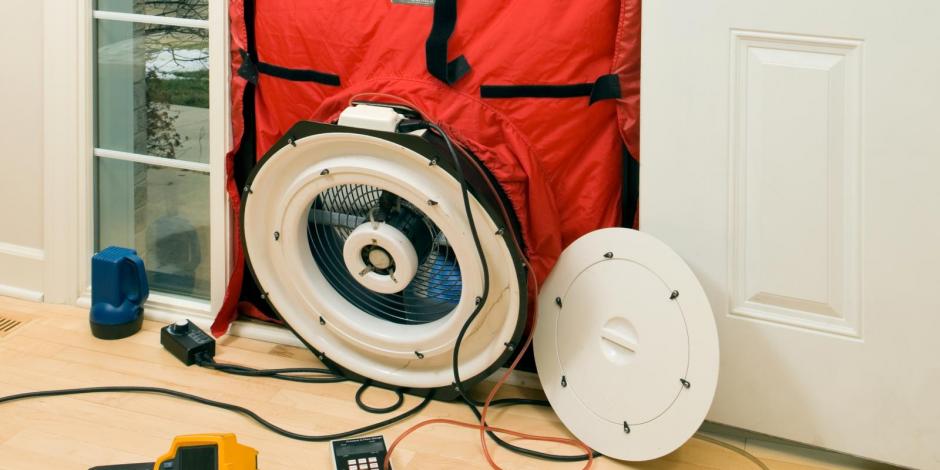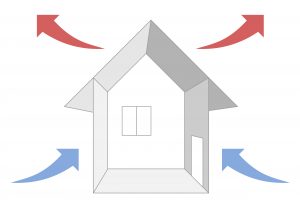What is a Blower Door Test?


States are slowly adopting more stringent requirements for energy efficiency. They have been doing this by adopting recent building code updates which means homes have to perform better. The question is, how do you measure energy efficiency and… what do you measure it against to know if results are good or bad? Introducing the blower door test! A blower door test is used to help determine a home’s airtightness. The key premise is that a home with lots of holes lets in lots of air thereby costing more to heat or cool. Heating and cooling is one of the highest consumers of energy for a home. The blower door test has been designated as THE test to see how leaky a home is.
Why use the Blower Door Test?
 A blower door test is a method that was chosen to provide the ability to measure air leakage in a building. An exterior door is opened and a blower door device is installed. In and of itself, a blower door test isn’t a high tech testing method. It doesn’t isolate any one system in a house or tell you where holes are. Rather it is a method to determine how leaky all systems working together actually are. It is incumbent upon contractors and homeowners to use the results of the test as a baseline to improve the performance of a home as leaks are found and sealed if results are worse than expected/required.
A blower door test is a method that was chosen to provide the ability to measure air leakage in a building. An exterior door is opened and a blower door device is installed. In and of itself, a blower door test isn’t a high tech testing method. It doesn’t isolate any one system in a house or tell you where holes are. Rather it is a method to determine how leaky all systems working together actually are. It is incumbent upon contractors and homeowners to use the results of the test as a baseline to improve the performance of a home as leaks are found and sealed if results are worse than expected/required.
Sealing these leaks means:
- Reducing energy consumption due to air leakage
- Avoiding moisture condensation problems
- Avoiding uncomfortable drafts caused by cold air leaking in from the outdoors
- Determining how much mechanical ventilation might be needed to provide acceptable indoor air quality.
That last bullet is important. Homes need fresh air for the health of its occupants. A common mantra in new home construction is: “Build tight and ventilate right.” This means mechanical ventilation may need to be installed to promote the healthy exchange of outside air and inside air for the home’s occupants.
How Does a Blower Door Test Work?
A building envelope is a physical separator between the conditioned and unconditioned environment of a home including the resistance to air, water and heat transfer. The powers that be decided we should test it to see how leaky it is. The actual test equipment consists of a calibrated fan, a panel to seal off an exterior door, and a flow and pressure meter.
The door panel is installed in an exterior door opening. All interior doors are opened, and all other exterior doors and windows are closed. Internal HVAC air returns and registers are left at their normal operating position. Fireplaces openings are sealed. Mechanical exhaust devices in the home (i.e. bathroom exhausts, kitchen range hood, and clothes dryer) should be turned off. Pressure tubing is used to measure the fan pressure, and it is also run to the exterior of the building. This allows the indoor/outdoor pressure differential to be measured. The test begins by sealing the face of the fan and measuring the baseline indoor/outdoor pressure differential. The average value is to be subtracted from all indoor/outdoor pressure differential measurements during the test.
Typically, the blower door fan is used to blow air out of the building, creating a negative pressure differential between inside and outside. This pressure difference forces air through all holes and penetrations in the building enclosure. The tighter the building (e.g. fewer holes), the less air is needed from the blower door fan to create a change in building pressure. States have that have adopted the newer building codes now require an air leakage rate of less than five Air Changes per Hour (5 ACH50) in climate zones 1 and 2, and a 3 ACH50 in zones 3 through 8 for new homes.
What is an ACH50?
The term ACH50 is used to tell us the number of times the air volume in a building changes per hour at 50 Pascals of pressure. It is calculated by taking CFM50 (which is the cubic feet of air moving through the fan at 50 pascals of negative pressure) times 60 minutes (to convert to hours) divided by the house’s volume.
I know it sounds complicated but we need that formula to create a basis for comparing homes to see how one may be “leakier” than another. It creates a vacuum pressure which is where the 50 Pascals comes in. The tester then measures the amount of air being sucked out of the home to maintain 50 Pascals and, with the formula above, we then determine how many Air Changes per Hour exist for a home.
RELATED: IS YOUR NEW HOME A SICK HOME?
A typical existing home may have a 7 ACH50 or higher. This means that it is leaky enough to exchange its entire volume of air 7 times in an hour at a pressure of 50 Pascals. Here is an idea of what expectations are for what is considered energy efficient homes:
- 1.5 – 3 ACH50 (climate zone dependent) is the current DOE Zero Energy Ready Home requirement
- .6 ACH50 under the standards of the Passivhaus Institut (PHI),
What Does the Blower Door Test Tell You?
Keep in mind that that actual air change rate from hour to hour or day to day in a home does not correlate to a blower door number achieved during the test. The rating of ACH50 was arbitrarily decided. For commercial buildings the depressurization value is ACH75. It also doesn’t count leakage from fireplace dampers (remember, they were closed off), dryers, and vents over the stove top. Variations also occur because of changes in temperature, wind, and humidity. This is just a test to try and create some baseline to measure the energy efficiency of a home to make improvements to the subject home and to compare it with others.
Leakier Homes – When a test is done on a new home the tests can tell you that you are outside of expected results. When this occurs it’s time to track down the leaks. Are there spaces/gaps around outlets and switches? Are there windows/doors that weren’t installed correctly and that is leaking air? Are there attic access panels that are missing gaskets? Lots of little things can add up to big air leaks in a home. These can be corrected and the test re-done.
Tighter Homes – If a home performs very well in a test it may need to be mechanically ventilated. This means outside air needs to be brought into the home on purpose because otherwise, its occupants are not getting enough fresh air into the home. This is done in a controlled fashion. For example, an Energy Recovery Ventilator (ERV) exchanges air from outside with air from inside. However, it recovered the energy (heat or cold) from the air before exchanging it thereby saving money. It also gives you the chance to filter the air because this exchange is happening in a controlled fashion.
Why Modular Homes Perform Better
When it comes to performing blower door tests, modular homes seem to perform better. Because modular homes are built in a factory, they tend to fit better. This means that lumber is drier so it doesn’t shrink over time creating gaps. Gaps around switches and outlets are sealed at the factory. Insulation is installed correctly and consistently. Overall home performance is just better because all these details are methodically managed in a factory construction/manufacturing environment. Do your research, learn more about the energy efficiency advantage of building your new home using modular construction.
The post What is a Blower Door Test? appeared first on Impresa Modular.




